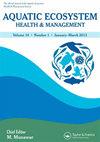Using the telecoupling framework to improve Great Lakes fisheries sustainability
IF 0.8
4区 环境科学与生态学
Q4 ENVIRONMENTAL SCIENCES
引用次数: 11
Abstract
Fisheries are coupled human and natural systems across space and time, involving movements of fish, money, and information in a globalized world. However, these social-ecological interactions over local to global scales are largely absent from the fisheries literature, as fisheries research to date has often been discipline- and location-specific. We analyzed this knowledge gap by using an emerging coupled human and natural systems research paradigm – the telecoupling framework – to investigate social-ecological interactions over distances (i.e. telecouplings) in the Great Lakes salmonine (i.e. Coho Salmon Oncorhynchus kisutch, Chinook Salmon O. tshawytscha) fishery. Since the 1960s, this fishery has involved telecoupled movements of fish, money, and information over relatively long distances facilitated by numerous individual and organizational agents. These telecouplings have been characterized by diverse social-ecological causes (e.g. decline of commercial fisheries, rising incomes and greater leisure time for recreational fishing) and effects (e.g. salmonine stocking, creation of angling- and tourism-based economies). Telecouplings are critical for fisheries professionals to consider because they promote holistic understanding of fisheries management while occasionally confounding conservation efforts (e.g. salmonine stocking spreads diseases and parasites and changes fish community structure and genetic integrity). Hence, fisheries professionals will benefit from using the telecoupling framework to optimize favorable and reduce unfavorable telecouplings and thereby enhance fisheries management programs. Overall, the telecoupling framework advances fisheries science by enabling fisheries professionals to systematically understand the causes and consequences of complex social-ecological fisheries interactions and develop informed strategies for sustainable fisheries management and governance throughout the Great Lakes and the world.利用远耦合框架改善五大湖渔业的可持续性
渔业是跨越空间和时间的人类和自然系统的结合,涉及全球化世界中鱼、钱和信息的流动。然而,这些从地方到全球尺度的社会生态相互作用在渔业文献中很大程度上是缺失的,因为迄今为止的渔业研究往往是特定学科和特定地点的。我们利用一个新兴的人类和自然系统耦合研究范式——远耦合框架——来研究五大湖鲑(Coho Salmon Oncorhynchus kisutch, Chinook Salmon O. tshawytscha)渔业的远距离社会生态相互作用(即远耦合),分析了这一知识差距。自20世纪60年代以来,这种渔业涉及在许多个人和组织代理人的推动下,在相对较长的距离上进行鱼、钱和信息的耦合流动。这些远程耦合的特点是社会生态原因(例如商业渔业的减少、收入的增加和休闲钓鱼的闲暇时间的增加)和影响(例如鲑鱼放养、以钓鱼和旅游为基础的经济的创造)多种多样。远程耦合对于渔业专业人员来说是至关重要的,因为它们促进了对渔业管理的整体理解,但有时也会混淆保护工作(例如,鲑鱼放养会传播疾病和寄生虫,并改变鱼类群落结构和遗传完整性)。因此,渔业专业人员将受益于使用远耦合框架来优化有利和减少不利的远耦合,从而加强渔业管理计划。总体而言,通过使渔业专业人员能够系统地了解复杂的社会生态渔业相互作用的原因和后果,并为整个大湖区和全世界的可持续渔业管理和治理制定明智的战略,远耦合框架推动了渔业科学的发展。
本文章由计算机程序翻译,如有差异,请以英文原文为准。
求助全文
约1分钟内获得全文
求助全文
来源期刊

Aquatic Ecosystem Health & Management
环境科学-海洋与淡水生物学
CiteScore
1.70
自引率
0.00%
发文量
1
审稿时长
18-36 weeks
期刊介绍:
The journal publishes articles on the following themes and topics:
• Original articles focusing on ecosystem-based sciences, ecosystem health and management of marine and aquatic ecosystems
• Reviews, invited perspectives and keynote contributions from conferences
• Special issues on important emerging topics, themes, and ecosystems (climate change, invasive species, HABs, risk assessment, models)
 求助内容:
求助内容: 应助结果提醒方式:
应助结果提醒方式:


